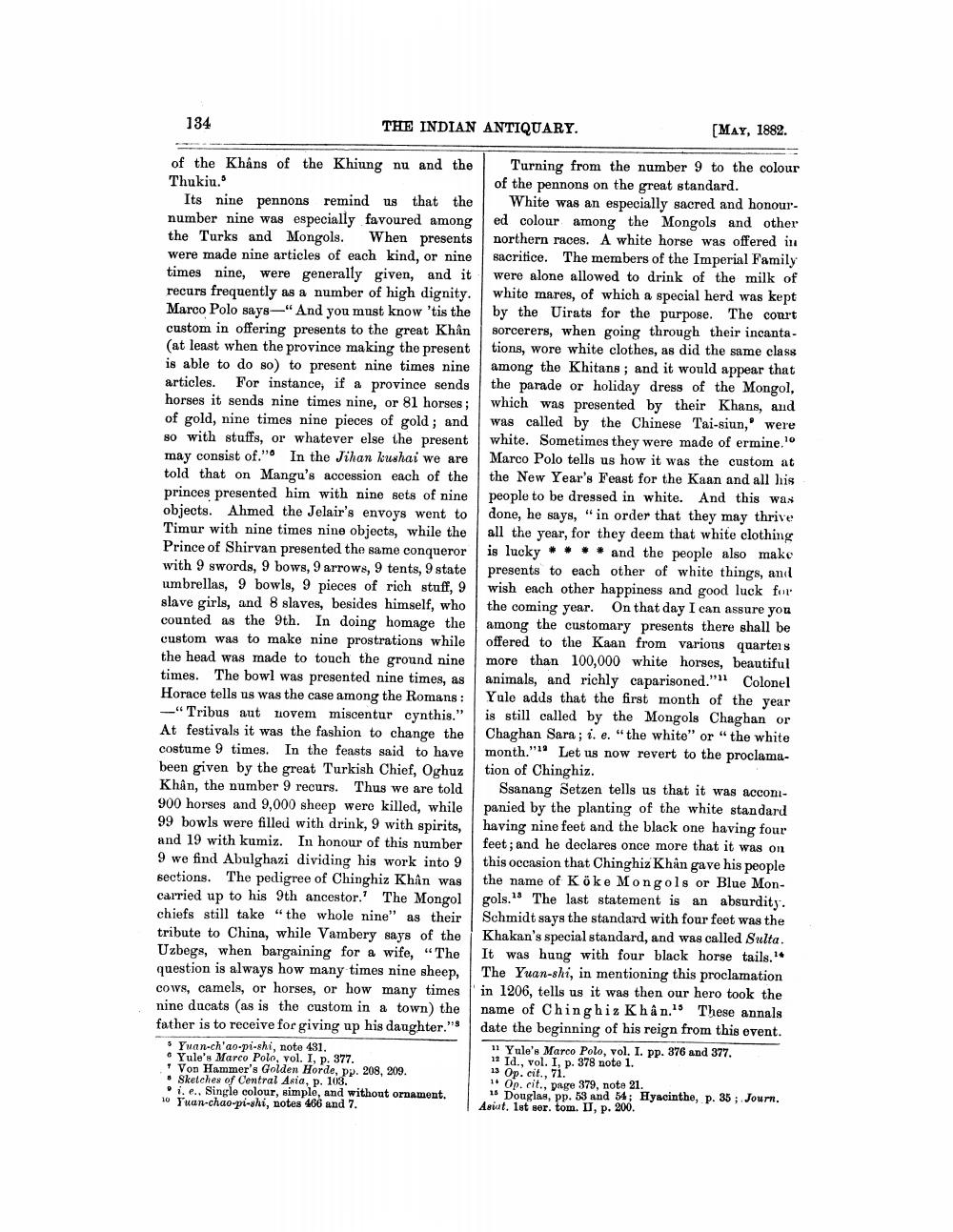________________
134
THE INDIAN ANTIQUARY.
of the Khans of the Khiung nu and the
Thukiu."
Its nine pennons remind us that the number nine was especially favoured among the Turks and Mongols. When presents were made nine articles of each kind, or nine times nine, were generally given, and it recurs frequently as a number of high dignity. Marco Polo says " And you must know 'tis the custom in offering presents to the great Khân (at least when the province making the present is able to do so) to present nine times nine articles. For instance, if a province sends horses it sends nine times nine, or 81 horses; of gold, nine times nine pieces of gold; and so with stuffs, or whatever else the present may consist of." In the Jihan kushai we are told that on Mangu's accession each of the princes presented him with nine sets of nine objects. Ahmed the Jelair's envoys went to Timur with nine times nine objects, while the Prince of Shirvan presented the same conqueror with 9 swords, 9 bows, 9 arrows, 9 tents, 9 state umbrellas, 9 bowls, 9 pieces of rich stuff, 9 slave girls, and 8 slaves, besides himself, who counted as the 9th. In doing homage the custom was to make nine prostrations while the head was made to touch the ground nine times. The bowl was presented nine times, as Horace tells us was the case among the Romans: -"Tribus aut novem miscentur cynthis." At festivals it was the fashion to change the costume 9 times. In the feasts said to have been given by the great Turkish Chief, Oghuz Khân, the number 9 recurs. Thus we are told 900 horses and 9,000 sheep were killed, while 99 bowls were filled with drink, 9 with spirits, and 19 with kumiz. In honour of this number 9 we find Abulghazi dividing his work into 9 sections. The pedigree of Chinghiz Khan was carried up to his 9th ancestor. The Mongol chiefs still take "the whole nine" as their tribute to China, while Vambery says of the Uzbegs, when bargaining for a wife, "The question is always how many times nine sheep, cows, camels, or horses, or how many times nine ducats (as is the custom in a town) the father is to receive for giving up his daughter."
Yuan-ch'ao-pi-shi, note 431.
Yule's Marco Polo, vol. I, p. 377.
Von Hammer's Golden Horde, pp. 208, 209.
Sketches of Central Asia, p. 103.
i. e.. Single colour, simple, and without ornament.
10 Yuan-chao-pi-shi, notes 466 and 7.
[MAY, 1882.
Turning from the number 9 to the colour of the pennons on the great standard.
White was an especially sacred and honoured colour among the Mongols and other northern races. A white horse was offered in sacrifice. The members of the Imperial Family were alone allowed to drink of the milk of white mares, of which a special herd was kept by the Uirats for the purpose. The court sorcerers, when going through their incantations, wore white clothes, as did the same class among the Khitans; and it would appear that the parade or holiday dress of the Mongol, which was presented by their Khans, and was called by the Chinese Tai-siun, were white. Sometimes they were made of ermine.10 Marco Polo tells us how it was the custom at the New Year's Feast for the Kaan and all his people to be dressed in white. And this was done, he says, "in order that they may thrive all the year, for they deem that white clothing is lucky and the people also make presents to each other of white things, and wish each other happiness and good luck for the coming year. On that day I can assure you among the customary presents there shall be offered to the Kaan from varions quarters more than 100,000 white horses, beautiful animals, and richly caparisoned." Colonel Yule adds that the first month of the year is still called by the Mongols Chaghan or Chaghan Sara; i. e. "the white" or "the white month." "Let us now revert to the proclamation of Chinghiz.
13
Ssanang Setzen tells us that it was accompanied by the planting of the white standard having nine feet and the black one having four feet; and he declares once more that it was on this occasion that Chinghiz Khan gave his people the name of Köke Mongols or Blue Mongols. The last statement is an absurdity. Schmidt says the standard with four feet was the Khakan's special standard, and was called Sulta. It was hung with four black horse tails. The Yuan-shi, in mentioning this proclamation in 1206, tells us it was then our hero took the name of Chinghiz Khân. These annals date the beginning of his reign from this event.
11 Yule's Marco Polo, vol. I. pp. 376 and 377.
12 Id., vol. I, p. 378 note 1.
13 Op. cit., 71.
Op. cit., page 379, note 21.
15 Douglas, pp. 53 and 54: Hyacinthe, p. 35; Journ. Asiat. 1st ser. tom. II, p. 200.




